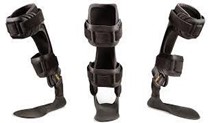Understanding Orthotics and Prosthetics for Pediatric Foot Deformities: A Guide for Parents
Foot deformities in children can be a source of concern for parents, but with appropriate intervention, many of these conditions can be effectively managed. Orthotic and prosthetic devices play a crucial role in correcting and supporting pediatric foot deformities, enhancing mobility, and improving quality of life. This comprehensive guide aims to provide parents with an understanding of these devices, their applications, and the benefits they offer to children.
Common Pediatric Foot Deformities
Several foot deformities can affect children, each requiring specific interventions:
- Clubfoot (Talipes Equinovarus): A congenital condition where the foot is twisted out of shape or position. Early treatment is essential to correct deformity and ensure normal development.
Wikipedia
- Flatfoot (Pes Planus): Characterized by the absence of a well-formed arch, leading to the entire foot pressing flat against the ground. While common in infants and toddlers, persistent flatfoot may require intervention.
Wikipedia
- High Arches (Pes Cavus): A condition where the foot has an abnormally high arch, potentially causing pain and instability. It may be associated with neurological disorders and often necessitates specialized support.
Wikipedia
- Metatarsus Adductus: A deformity where the front half of the foot turns inward. It is one of the most common foot deformities in infants and can often be treated with stretching exercises or casting.
Orthotic Devices for Pediatric Foot Deformities
Orthotic devices are custom-made support designed to align and support the foot and ankle, improving function and alleviating discomfort. Common orthotic devices include:
 Ankle-Foot Orthoses (AFOs): These devices encompass the foot, ankle, and lower leg, providing stability and correcting alignment. They are commonly prescribed for children with conditions causing joint instability, irregular walking patterns, and muscle weakness or stiffness.
Ankle-Foot Orthoses (AFOs): These devices encompass the foot, ankle, and lower leg, providing stability and correcting alignment. They are commonly prescribed for children with conditions causing joint instability, irregular walking patterns, and muscle weakness or stiffness.
Scottish Rite for Children
 Dynamic Ankle-Foot Orthoses (DAFOs): A type of AFO that is thin, flexible, and wraps around the entire foot, providing improved sensation and alignment. DAFOs are designed to help maintain a functional position, improving stability for standing and walking.
Dynamic Ankle-Foot Orthoses (DAFOs): A type of AFO that is thin, flexible, and wraps around the entire foot, providing improved sensation and alignment. DAFOs are designed to help maintain a functional position, improving stability for standing and walking.
Wikipedia
- Supramalleolar Orthoses (SMOs): These braces extend just above the ankle bones and are used to control foot position, providing support for children with mild to moderate foot and ankle conditions, such as hypermobility or pronation.

Prosthetic Devices for Pediatric Foot Deformities
In cases where a child is born without a foot or has undergone an amputation due to injury or illness, prosthetic devices are used to replace the missing limb segment. Pediatric prosthetics are custom designed to accommodate growth and provide functionality, enabling children to engage in daily activities.
Benefits of Orthotic and Prosthetic Interventions
The use of orthotic and prosthetic devices in children with foot deformities offers several benefits:
- Improved Mobility: By providing support and alignment, these devices enable children to walk, run, and participate in physical activities with greater ease.
- Pain Reduction: Proper alignment and support can alleviate discomfort associated with foot deformities.
- Enhanced Development: Early intervention with appropriate devices can promote normal musculoskeletal development, preventing further complications.
- Increased Independence: With improved mobility and function, children can perform daily activities more independently.
The Role of Parents in Orthotic and Prosthetic Care
As a parent, your involvement is crucial in the successful use of orthotic and prosthetic devices:
- Ensure Proper Fit: Regularly consult with healthcare providers to ensure the device fits well, especially as your child grows.
- Encourage Compliance: Motivate your child to wear the device as prescribed to achieve the best outcomes.
- Monitor for Issues: Watch for signs of discomfort, skin irritation, or changes in your child’s gait, and report them to the healthcare provider promptly.
- Promote Physical Activity: Encourage your child to engage in appropriate physical activities to strengthen muscles and improve overall health.
Trusted Resources for Further Information
- Ankle-Foot Orthosis Devices: A Guide for Parents
- Pediatric Foot Deformities: An Overview
- Pediatric Orthotics and Prosthetics | Children's Healthcare of Atlanta
- Pediatric Orthotics | Nemours Children's Health
- Foot orthoses for treating paediatric flat feet - PMC - PubMed Central
- Clubfoot - Wikipedia
- Pediatric Podiatry - Wikipedia
- Ignacio Ponseti – Wikipedia


Comments({{ comments_count }})
{{ item.name }}
{{ item.created_at_format }}{{ item.message }}
Leave a Reply
Leave a Reply